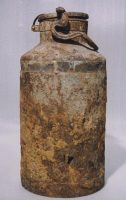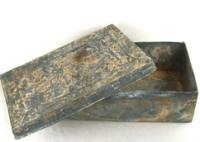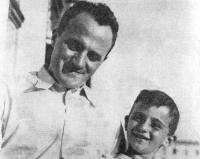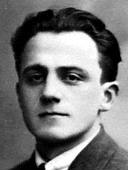As has been noted elsewhere, there is a long-held tradition among Jews of recording the history
of their many persecutions. Nowhere is this better illustrated than in the life and work of
Emanuel Ringelblum and his establishment and administration of the
Oneg Shabbat
Archive (also known as the Ringelblum Archive) in
Warsaw.
Emanuel Ringelblum was born in
1900 in
Buczacz.
He graduated from
Warsaw University, being awarded a doctorate in
1927 for his thesis on the history of the Jews of
Warsaw
in the Middle Ages. For several years he taught history in Jewish schools and was also active in
public affairs.
From an early age he was also an active member of the "Po'alei Zion Left" political movement (Marxist-Zionists),
a completely separate party from "Po'alei Zion Right" (essentially Social democrat - Zionists).
In
1930 he had become a part-time employee
of the Joint Distribution Committee (“The Joint”), and in
November 1938
was sent by them to the
Zbaszyn camp, where 6,000 Jews (Polish citizens expelled
from Germany) were gathered.
Ringelblum spent five weeks at the camp, where he directed relief work, collected testimonies
from the deportees, and gathered information on events in Nazi Germany. His experiences
during this period left an indelible impression.
In the early stages of the German attack on
Warsaw, Ringelblum
participated in the activities of the coordinating committee of Jewish aid organizations. Later, when
the
Jüdische Soziale Selbsthilfe (Zydowska Samopomoc Spoleczna) for self-help
evolved from this committee, Ringelblum headed the department dedicated to the promotion of
mutual assistance, including help to the needy and shelter to the deportees and those whose
homes had been destroyed. He was responsible for a nexus of soup kitchens serving tens
of thousands of soup portions to the impoverished inhabitants of the ghetto. He also organized
the so-called “House Committees”, which were to play a vital part in the strategy of survival.
In addition to these important activities, Ringelblum worked with the political underground,
particularly the sector devoted to cultural affairs.
As indispensable as these undertakings were, Ringelblum also found time for the two projects
for which he is best remembered today. These were the
Oneg Shabbat Archive and his
personal chronicle of events.
Oneg Shabbat is Hebrew for “Sabbath delight”, a reference
to the traditional Sabbath afternoon gathering for study and discussion. The code name
Oneg Shabbat
was used because those responsible for maintaining the archive held their secret meetings
on the Sabbath. Ringelblum recorded the manner in which the Archive evolved and its purpose:
"
I began to collect material on current events in
October 1939. As head of the Jewish Self-Help welfare organization
(which was known then as the Coordinating Committee of the welfare organizations), I had daily personal
contact with the life around me. Information reached me on everything that happened to Jews in
Warsaw or the suburbs. The Coordinating Committee was
at that time a branch of the Joint, and delegations from the smaller towns arrived almost daily to
describe the difficulties experienced by the Jewish population. Whatever I heard in the course
of the day I wrote down in the evening, and added my observations. In time these daily records
made up a good-sized book of some hundreds of closely written pages, a mirror of that time.
The daily records were replaced first by weekly summaries, and later monthly summaries. I did this
at a time when the number of colleagues working for the "Oneg Shabbat" had already become larger....
In May 1940 I decided that it would be proper to find wider support
for this important work. I made a careful choice of people for the job and as a result the work
progressed in the right direction and could be carried out in sufficient measure. The secretary of
"Oneg Shabbat," Hersz Wasser, was appointed by the
Committee of "Oneg Shabbat" at that time, and he has continued with the work to the present day....
The creation of the ghetto, and the shutting away of the Jews within the walls, brought about
even greater opportunities for work on the archives. We reached the conclusion that the
Germans took very little interest in what the Jews were doing amongst themselves. There were
meetings on subjects and in a manner that would not have been possible before the war.
One said everything that came to mind at every meeting of a house committee, in every soup-kitchen,
and on the premises of every public institution, without interference. The Jewish Gestapo
agents were busy looking for the rich Jews with hoarded goods, smugglers, etc. Politics interested
them little. It went so far that illegal publications of all political directions appeared almost openly.
In the cafes they were read practically in public; money was collected for the newspaper fund, there
were arguments with opponents – in a word, people behaved almost like before the war. In conditions
of such "freedom" among the slaves of the ghetto it was not surprising that the work of
"Oneg Shabbat" could develop successfully ...."
Ringelblum was the inspiration behind the creation of the Archive. The secretary, and only surviving
member of the “
Oneg Shabbat” group,
Hersz Wasser, recorded:
"
Every item, every article, be it long or short, had to pass through
Dr Ringelblum’s hands… For weeks and months he spent the nights poring over the manuscripts,
adding his comments and instructions… The collaborators of the Archive were considered
soldiers of the underground army. It is not surprising that the secret archive was appropriated by
the fighting ghetto. The Archive established the press department for the Jewish Fighting
Organization and for editors of underground newsletters both in the ghetto and on the Aryan side."
The Archive was to reach enormous proportions. By
early 1942,
so much material had been gathered that it was decided to create a synthesis, a project
with the title “Two and a Half Years”, representing the period since
September 1939
during which Poland had been occupied by the Germans. A book of some 2,000 pages was planned,
divided into four sections: 1. general; 2. economic; 3. cultural – scientific – literary – artistic; 4.
social welfare. Apart from underground newspapers published by different political parties, letters
received in the ghetto considered to be of interest, minutes of meetings, reports on the activities
of Jewish public organizations, and the testimonies of Jews from other ghettos or labour camps
arriving in
Warsaw, the Archive sponsored papers on many
other subjects. These included the
role of Jewish women in the war; children and youth in the ghetto; problems of health; welfare and
self-help; humour and folklore; relations between Poles and Jews; relations between Germans
and Jews; education; cultural activities; religious affairs; the theatre in the ghetto; political and
underground organizations; the smuggling of food; and the secret economy.
Of the two parts of the Archive that have survived, the first contains 1,505 files and the second
558 files. Each file consists of as many as a dozen documents, varying in length from a single
page to works of many pages. The first part comprises 20,740 pages, the second part 7,906 pages.
Some pages were written in Polish, others in Yiddish, Hebrew or German. Also included in the
Archive were several dozen photographs, as well as paintings and drawings, and the diaries
and notes of Ringelblum,
Abraham Lewin, Peretz Opoczynski,
Shimon Huberband and others.
It was attempted to include as many German documents as possible in the Archive concerning
the deportation and murder of Jews, not only from
Warsaw, but
also from other towns and cities. In
January 1942, a man named
Szlamek Bajler (also known as
Yakov Grojanowski) escaped from the
Chelmno death camp to the
Warsaw Ghetto. He provided the first
report about
Chelmno to Ringelblum and
Wasser. Because the
Gestapo was looking for
Bajler, Ringelblum sent him to the
Zamosc Ghetto where
Bajler’s
sister-in-law lived. When the first deportations to
Belzec started,
Bajler
sent post cards to Ringelblum and
Wasser in which he
provided information about
Belzec.
He wrote in a combination of Polish and in Yiddish using Polish lettering:
"
In Belzec iz Beit Olam wie in
Chelmno"
(“In
Belzec there is a cemetery [literally `Home of Eternity'] as in
Chelmno”).
Bajler was the first person to officially inform Ringelblum about
Belzec. During the first
Aktion in
Zamosc on
14 April 1942,
Bajler was
deported to
Belzec together with his sister-in-law. The son of his sister-in-law
sent a message to
Wasser confirming their deportation.
Hersz Wasser wrote:
“
… The leadership of the underground in the ghetto
charged `Oneg Shabbat’ with the task of preparing various memoranda for consumption abroad, e.g.,
on the death camp at Chelmno (March 1942),
on the Aktion in
Lublin (April 1942),
on the state of the Jewish population in the Nazi-occupied areas
(July 1942), and later on, in November 1942,
the first exhaustive description of the initial stage of the liquidation of Warsaw
Jewry.” (See
"What was known, what was done by the Allies")
 |
"Oneg Shabbat"
Milk Can * |
 |
"Oneg Shabbat"
Metal Container * |
As the intended annihilation of the Jews became more evident, it was decided to hide the
invaluable material contained in the Archive in a series of secure places. The collection was sealed
inside metal containers and milk cans and concealed within the ghetto in
August 1942, and in
March and April 1943.
Those who carried out this task did not survive. On
3 August 1942,
a schoolteacher and archivist,
Izrael Lichtensztajn, assisted by two
of his former pupils,
Dawid Graber and
Nachum Grzybacz,
buried ten metal boxes and milk cans at
Nowolipki 68. 19 year-old
Graber wrote a note and included it with the interred Archive:
“
The men who buried the archives know that they may not
survive to see the moment when the treasure is dug up and the whole truth proclaimed…
What we were unable to scream out to the world, we have concealed under the ground…
One thing I am proud of, namely, that in these disastrous and horrible days I had been chosen to
help bury the treasure, in order that you may know of the tortures and murders of the
Nazi tyrants… Blessed be those whom fate saved from suffering.”
That first section of the Archive was recovered on
18 September 1946.
The second part was found nearby four years later, on
1 December 1950.
A third part, which included material on the organization and activities of the underground
and the Jewish Fighting Organization has never been discovered, and is now presumed lost
forever. It is probable that there were also a number of other containers buried and
never subsequently recovered.
The surviving
Oneg Shabbat Archive is kept by
Zydowski Instytut Historyczny
(ZIH – Jewish Historical Institute,
Warsaw), and represents the most important
single source for the history of Polish Jewry during the war and the
Shoah. It was created
through the immense courage and devotion of an unknown number of individuals, but perhaps
most of all through the dedication of its founder and guiding light, Emanuel Ringelblum.
 |
| Ringelblum and his Son Uri * |
Ringelblum’s fate was tragic. He had repeatedly been invited to shelter on the “Aryan” side of
Warsaw, and in
March 1943, together with his wife
Yehudit and 13 year-old son
Uri,
he finally did so. On the eve of
Passover
1943 he returned to the ghetto alone, just as the uprising was beginning. What happened to
him in the ensuing fighting is not known, but in
July 1943 he
was found in
Trawniki by two members of the underground, who managed to extricate him from
the camp and return him to
Warsaw disguised as a railway worker.
Together with his family and 38 other Jews, he hid in a bunker in “Aryan”
Warsaw. On
7 March 1944, the hiding place was
betrayed, and the captives taken to the
Pawiak Prison. Another Jewish prisoner in Pawiak,
Julian Hirszhaut, became involved in an attempt to move Ringelblum from the
condemned cells into those holding prisoners expected to be sent to work for the Germans as
tailors and shoemakers.
Hirszhaut recalled how he had managed to enter
the cell where Ringelblum was being held:
"
The cell was jammed with people, apparently these were
the Jews whom the Germans had seized with Ringelblum in the bunker. Ringelblum
himself was sitting on a straw mattress close to the wall... On his lap he was holding
a handsome boy. This was his son, Uri... I told him that we were making attempts to
take him in with us.
'And what will happen to him?’ he asked, pointing his finger at his son. 'And what will happen
to my wife who is in the women’s section?'
What could I answer him? We all knew well that even if we succeeded in taking Ringelblum
out of there and bringing him to us as a shoemaker or tailor, his family would still be doomed.
My silence conveyed the truth to him, and he added right away: 'Then I prefer to go the way
of Kiddush Ha-Shem (The Sanctification of God’s Name) together with them.'
Later he told me how he had been tortured by the Gestapo... In the middle of our conversation
he suddenly asked: 'Is death so hard to bear?' And then, a little later, he went on with a
voice broken from despair: 'What is this little boy guilty of?' – and he again pointed his finger
at his son - 'It breaks my heart to think of him.'
I stood helpless before Ringelblum, I did not know what to answer, and a wave
of sorrow swept over my heart."
A few days later, Ringelblum, his family, and the other Jews who had been captured together
with them in the bunker were executed in the ruins of the ghetto. The person who had betrayed
the location of the bunker, 18 year-old
Jan Lakinski, was later
sentenced to death by a tribunal in
Warsaw.
Ringelblum kept his own personal record, not so much as a diary, but rather as a chronicle
of events. It was published after the war as "Notes from the Warsaw Ghetto". He was in no doubt
about Nazi intentions. On
25 June 1942, less than one month
before the deportations from
Warsaw to
Treblinka began, he wrote:
“
The extermination is being executed according to a plan and
schedule prepared in advance. Only a miracle can save us: the sudden end of the war. Otherwise, we are lost.”
He provided remarkable insights into the reaction of the Jewish population and their self-deception
as persecution turned to annihilation. On “everyday” death in the ghetto he recorded:
"
One of the problems of great import is the passivity of the
Jewish masses, dying without a whimper. Why are they so quiet? Why are fathers, mothers,
and all the children dying without protest? ... Various reasons can be found. Intimidation
by the (German)
authorities is so great that people
are scared to raise their heads, fearing mass terror against the hungry in case of any turbulence.
This is the reason why the socially responsible remain silent, passive, so as not to cause
turbulence in the ghetto. Others, having a little initiative, find some sort of accommodation…
The shops and the orders that came from German cells provide employment for large numbers
of workers and artisans. Some… trade in the streets... The rest are passive, helpless people
who are simply dying out... The dying are mainly refugees from out of town... After a little
shouting they keep quiet, become resigned, and simply wait to die, as if yearning for the
moment when death will deliver them from suffering.”
And on the reaction as the deportations began:
“
... A legend began to grow up about letters from the deportees,
particularly from certain places – Brzesc, Kowel, Pinsk, etc.
Hard as you might try, you could never get to anyone who had actually read a letter with his
own eyes. It was always a third person who had heard from someone else that so-and-so had
read the letter. These letters were always phrased in exactly the same way and appeared in
the same form... A letter like this never contained details about the living conditions of the
deportees or how they occupied their time. But they always requested money and belongings...
... Such letters were always delivered by Polish Christians who 'managed to reach
(the proper address)
after overcoming various difficulties.’
The amicable Poles were willing to take money and clothing back for the deportees. They were
also prepared to aid in the search for others who had been deported – naturally, in return
for the payment of hundreds of thousands of zlotys. And there were people who paid out tens
of thousands of zlotys to find their closest relatives… But even though such news from relatives
was exposed as a swindle time and time again, others could always be found who were willing
to pay a high price for the slightest news of their loved ones... These swindlers play on the
popular imagination, which constantly dreams – and will not stop dreaming – that the hundreds
of thousands and millions of deportees are alive, are working, and will even return...”
In a text that was written after the initial deportations, Ringelblum expanded on this phenomenon:
"
I am deeply convinced that even today, when the meagre
remnant of the Jews of Warsaw know about
Treblinka, there are still hundreds and perhaps even thousands
of people who nevertheless believe in the bogus reports about an alleged children’s camp.
Thus just a few days ago, rumours circulated about 2,000 children who had returned from
Treblinka. I believe that years after this war ends, when
all the secrets about the death camps have long been exposed, wretched mothers will continue
to dream that the children torn from them are still alive somewhere in the depths of Russia...”
Ringelblum always tried to present a balanced picture. For example, he was as equally
condemnatory of the ghetto’s Jewish police as he was of Polish fraudsters and anti-Semites:
“
The Jewish police enjoyed a bad opinion even before the
start of the 'resettlements'... But their meanness reached a pinnacle in the course of the
deportations... The police became mentally conditioned to doing this dirty work and, therefore,
performed it with perfection... There are people who maintain that each society has the police
it deserves, that the malaise of helping the occupier slaughter 300,000 Jews infected the entire
society and not (only)
the police, which are only a mirror
of the society. But there were others who, trying to survive the holocaust, maintained that the
will to survive the war justified all means, even (the sacrifice of)
human lives.”
Yet, equally, on
26 April 1941, Ringelblum recorded that a delegation
of the ghetto police in
Warsaw refused to continue catching
Jews for work in labour camps.
Some of the police declared that they were ready to go to the camps themselves. In his writing,
as in his life, Ringelblum constantly attempted to be even-handed in his presentation of evidence.
After the deportations began in
July 1942, Ringelblum became an
advocate of armed resistance through the
Zydowska Organizacja Bojowa (ZOB - Jewish Fighting
Organization.) But ever the historian, Ringelblum continued writing to the end. He had already
penned biographical notes on many of the outstanding Jewish personalities, including
Yizhak Gitterman,
Mordechai Anielewicz,
Ignacy Schiper, Meir Balaban, and
Janusz Korczak. Now, whilst in hiding in “Aryan”
Warsaw
for the second time, he completed his last two books. The first was a history of the
Trawniki camp (a book which did not survive the war), the second a history of
Polish-Jewish relations during WW 2.
In the latter he was scathing about most Poles indifference, at best, to the fate of the Jews, which
he attributed to generations of anti-Semitism. Yet at the same time he was unstinting in his admiration
of those Poles who had endangered their own lives in order to save Jews:
"
“Idealists from among both the educated and the working classes,
who saved Jews at the risk of their lives and with boundless self-sacrifice – there are thousands such in
Warsaw and the whole country. The names of these people,
on whom the Poland to come will
bestow insignia for their human acts, will forever remain engraved in our memories, the names of
heroes who saved thousands of human beings from destruction in the fight against the greatest
enemy of the human race.”
Among the Poles specifically mentioned by Ringelblum in his book as rescuers of Jews were
Teodor Pajewski, who had helped him to
escape from
Trawniki;
Mieczyslaw Wolski, in whose bunker he had
hidden in “Aryan”
Warsaw,
and who was shot by the Germans after the bunker was discovered; and
Julian Kudasiewicz, Gerhard Gadejski, Professor
Tadeusz Kotarbinski, Pawel Harmusszko, Witold Benedyktowicz, and
Ignacy Kasprzykowski.
Heroism can take many forms. The soldier who displays his courage on the battlefield is perhaps
the most obvious example. But there is also the quiet, passive heroism of the individual who resists,
not with the rifle but with the pen. There were many such men and women among the doomed
Jews of Poland. None exemplifies this gallantry and dedication more than Emanuel Ringelblum,
whose legacy remains the body of work he tried so desperately to preserve and which will forever
remain his memorial.
Photos:
Gilbert, Martin.
The Holocaust *
Wiesenthal Learning Center
*
Wikipedia
*
Sources:
Gutman, Yisrael, ed.
Encyclopedia of the Holocaust, Macmillan Publishing Company, New York, 1990
Gutman, Yisrael.
The Jews Of Warsaw 1939-1943, Indiana University Press, Bloomington and Indianapolis, 1989
Gilbert, Martin.
The Holocaust – The Jewish Tragedy, William Collins Sons & Co. Limited, London, 1986
Grynberg, Michal, ed.,
Words to Outlive Us - Eyewitness Accounts from the Warsaw Ghetto, Granta Books, London 2003
Trunk, Isaiah.
Judenrat – The Jewish Councils in Eastern Europe under Nazi Occupation, University of Nebraska Press, Lincoln, 1996
www.jewishvirtuallibrary.org
www.jewishgates.com
www.centropa.org
www.raoulwallenberg.net
© ARC 2006










